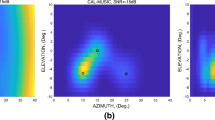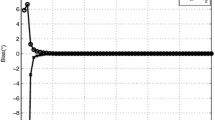Abstract
In sparsity-based optimization problems, one of the major issue is computational complexity, especially when the unknown signal is represented in multi-dimensions such as in the problem of 2-D (azimuth and elevation) direction-of-arrival (DOA) estimation. In order to cope with this issue, this paper introduces a new sparsity structure that can be used to model the optimization problem in case of multiple data snapshots and multiple separable observations where the dictionary can be decomposed into two parts: azimuth and elevation dictionaries. The proposed sparsity structure is called joint-block-sparsity which enforces the sparsity in multiple dimensions, namely azimuth, elevation and data snapshots. In order to model the joint-block-sparsity in the optimization problem, triple mixed norms are used. In the simulations, the proposed method is compared with both sparsity-based techniques and subspace-based methods as well as the Cramer–Rao lower bound. It is shown that the proposed method effectively solves the 2-D DOA estimation problem with significantly low complexity and sufficient accuracy.


Similar content being viewed by others
References
Caliciotti, A., Fasano, G., & Roma, M. (2018). Preconditioned nonlinear conjugate gradient methods based on a modified secant equation. Applied Mathematics and Computation, 318, 196–214. (Recent Trends in Numerical Computations: Theory and Algorithms) .
Candès, E. J., Romberg, J. K., & Tao, T. (2006). Stable signal recovery from incomplete and inaccurate measurements. Communications on Pure and Applied Mathematics, 59(8), 1207–1223.
Candès, E., & Wakin, M. (2008). An introduction to compressive sampling. IEEE Signal Processing Magazine, 25, 21–30.
Cotter, S., Rao, B., Engan, K., & Kreutz-Delgado, K. (2005). Sparse solutions to linear inverse problems with multiple measurement vectors. IEEE Transactions on Signal Processing, 53, 2477–2488.
Dassios, I. K. (2015). Optimal solutions for non-consistent singular linear systems of fractional nabla difference equations. Circuits, Systems, and Signal Processing, 34, 1769–1797.
Dassios, I., Fountoulakis, K., & Gondzio, J. (2015). A preconditioner for a primal–dual Newton conjugate gradient method for compressed sensing problems. SIAM Journal on Scientific Computing, 37(6), A2783–A2812.
Elbir, A. M., & Tuncer, T. E. (2016). 2D-DOA and mutual coupling coefficient estimation for arbitrary array structures with single and multiple snapshots. Digital Signal Processing, 54, 75–86.
Filik, T., & Tuncer, T. E. (2010). A fast and automatically paired 2-D direction-of-arrival estimation with and without estimating the mutual coupling coefficients. Radio Science, 45(3), RS3009.
Friedlander, B., & Weiss, A. (1991). Direction finding in the presence of mutual coupling. IEEE Transactions on Antennas and Propagation, 39, 273–284.
Hyder, M., & Mahata, K. (2010). Direction-of-arrival estimation using a mixed \(l_{2,0}\)-norm approximation. IEEE Transactions on Signal Processing, 58, 4646–4655.
Krim, H., & Viberg, M. (1996). Two decades of array signal processing research: The parametric approach. IEEE Signal Processing Magazine, 13, 67–94.
Malioutov, D., Cetin, M., & Willsky, A. (2005). A sparse signal reconstruction perspective for source localization with sensor arrays. IEEE Transactions on Signal Processing, 53, 3010–3022.
Rao, B. D., & Kreutz-Delgado, K. (1999). An affine scaling methodology for best basis selection. IEEE Transactions on Signal Processing, 47, 187–200.
Roy, R., & Kailath, T. (1989). ESPRIT-estimation of signal parameters via rotational invariance techniques. IEEE Transactions on Acoustics, Speech and Signal Processing, 37, 984–995.
Schmidt, R. (1986). Multiple emitter location and signal parameter estimation. IEEE Transactions on Antennas and Propagation, 34, 276–280.
Stoica, P., & Nehorai, A. (1990). Performance study of conditional and unconditional direction-of-arrival estimation. IEEE Transactions on Acoustics, Speech, and Signal Processing, 38, 1783–1795.
Wax, M., & Kailath, T. (1985). Detection of signals by information theoretic criteria. IEEE Transactions on Acoustics, Speech, and Signal Processing, 33, 387–392.
Wu, Q., Sun, F., Lan, P., Ding, G., & Zhang, X. (2016). Two-dimensional direction-of-arrival estimation for co-prime planar arrays: A partial spectral search approach. IEEE Sensors Journal, 16, 5660–5670.
Yang, Z., Li, J., Stoica, P., & Xie, L. (2017). “Chapter 11—Sparse methods for direction-of-arrival estimation,” Volume 7 of Academic Press Library in Signal Processing. Amsterdam: Elsevier.
Yang, Z., & Xie, L. (2015). On gridless sparse methods for line spectral estimation from complete and incomplete data. IEEE Transactions on Signal Processing, 63, 3139–3153.
Zhao, G., Shi, G., Shen, F., Luo, X., & Niu, Y. (2015). A sparse representation-based DOA estimation algorithm with separable observation model. IEEE Antennas and Wireless Propagation Letters, 14, 1586–1589.
Ziskind, I., & Wax, M. (1988). Maximum likelihood localization of multiple sources by alternating projection. IEEE Transactions on Acoustics, Speech and Signal Processing, 36, 1553–1560.
Author information
Authors and Affiliations
Corresponding author
Additional information
Publisher's Note
Springer Nature remains neutral with regard to jurisdictional claims in published maps and institutional affiliations.
Appendices
Appendices
1.1 Derivation of (18)
Using \(\textit{factored representation}\) as in Cotter et al. (2005) and Rao and Kreutz-Delgado (1999), the gradient of the cost function (18), \(J(\{\mathbf{P}_k\}_{k=1}^K)\), is given as follows
where \(\bar{\mathbf{H}}_{\phi } = [\mathbf{Q}_1^H\mathbf{A}_{\phi },\ldots ,\mathbf{Q}_K^H\mathbf{A}_{\phi }]\). The gradient of the first term in (22) is \(\nabla _{{P}} \{ || \tilde{\mathbf{P}}||_{2,2,1}\} = {\varPi }(\mathbf{P})\mathbf{P}\) (Cotter et al. 2005) where \({\varPi }(\mathbf{P}) \in \mathbb {C}^{N_{\theta } \times N_{\theta }}\) can be computed as
where \(l\le 1\) (Cotter et al. 2005; Rao and Kreutz-Delgado 1999), \(\tilde{\mathbf{p}} \in \mathbb {C}^{N_{\theta }}\) and
By equating the gradient in (22) to zero we get
Then we have the solution for \(\mathbf{P}\) as
1.2 Derivation of (19)
In a similar way as in Appendix 7.1 (Cotter et al. 2005; Rao and Kreutz-Delgado 1999), we have the gradient of the cost function in (19), \(J(\{\mathbf{Q}_k\}_{k=1}^K)\), as
where \(\tilde{\mathbf{H}}_{\phi } = [\mathbf{A}_{\phi }{} \mathbf{P}_1^T,\ldots ,\mathbf{A}_{\phi }{} \mathbf{P}_K^T]\in \mathbb {C}^{N_{\phi }\times N_{\theta }K }\), \({\varPi }(\mathbf{Q}) = l \cdot \text {diag}(\tilde{\mathbf{q}}^{l-2} ) \) for \(\tilde{\mathbf{q}} \in \mathbb {C}^{N_{\phi }}\) and
By equating the gradient to zero we get
Then we have the solution for \(\mathbf{Q}\) as
Rights and permissions
About this article
Cite this article
Elbir, A.M. Joint-block-sparsity for efficient 2-D DOA estimation with multiple separable observations. Multidim Syst Sign Process 30, 1659–1669 (2019). https://doi.org/10.1007/s11045-018-0623-z
Received:
Revised:
Accepted:
Published:
Issue Date:
DOI: https://doi.org/10.1007/s11045-018-0623-z




